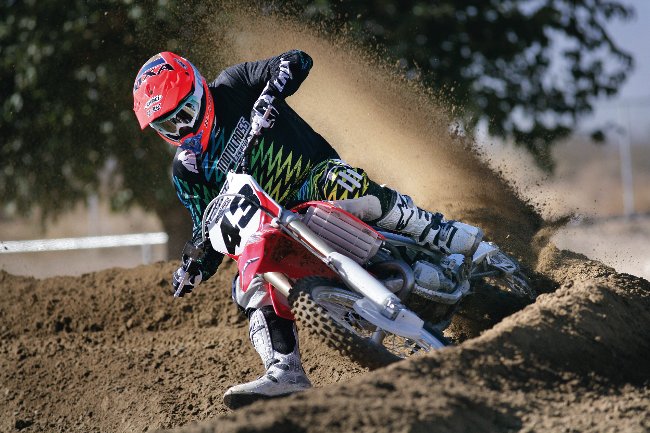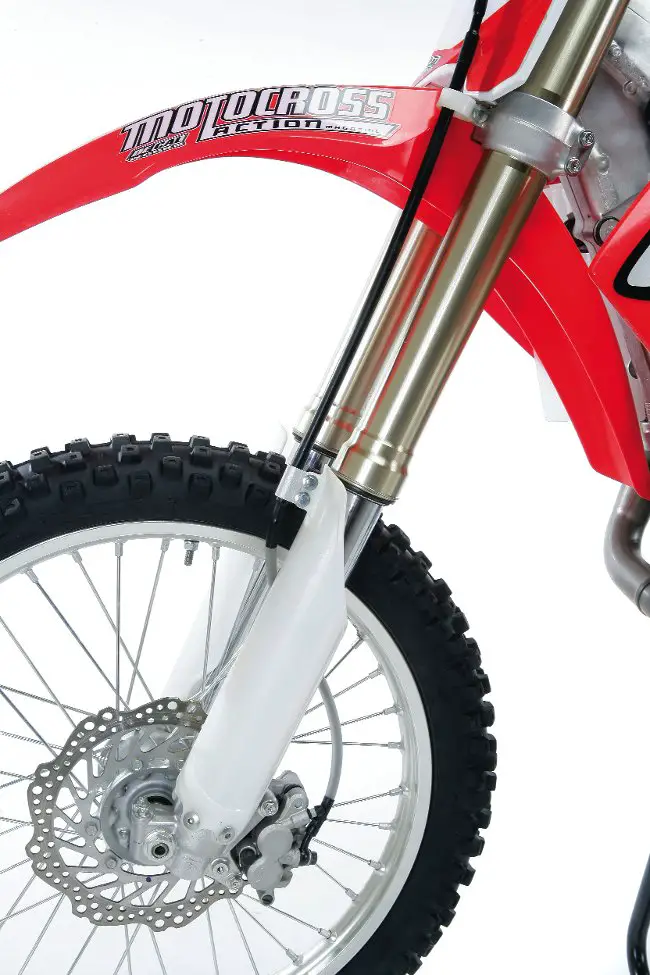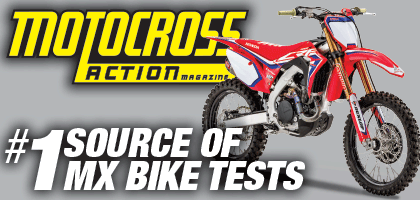REAL TESTS! 2010 MXA RACE TEST OF THE HONDA CRF450:

Q: FIRST AND FOREMOST, IS THE 2010 CRF450 BETTER THAN THE 2009 CRF450?
A: Yes and no. The small number of changes that Honda made for 2010 culminate in a bike that is a little better in several areas and a little worse in others (although the “worse” parts are subjective and can be undone).
Q: WHAT ARE THE MAJOR CHANGES THAT HONDA MADE TO THE 2010 CRF450?
A: Calling them “major changes” is a bit of a stretch, but here is a list of the five areas that Honda massaged. Let us count the mods.
(1) EFI map. The programmable electronic control module has been reprogrammed for a gentler, kinder CRF450. Honda’s goal was to get away from the barky on/off throttle response of 2009, smooth out the powerband and improve starting. According to Honda, the new EFI map is last year’s preprogrammed map, but a totally new map. What does that mean? It means that the 2010 map is reconfigured to read 0, 0, 0, 0 on the software’s charts and graphs. What does that mean? It means that the 2009 map is not comparable to the 2010 map because the 2009 map was also configured as 0, 0, 0, 0. What does that mean? It means that last year’s maps are no longer comparable to this year’s maps because the baseline numbers have changed. There are other reprogramming issues, which we will get to later.
(2) Automatic compression release. You may have heard that the 2010 CRF450 has a new cam, but what it really has is the same cam profile (lift and duration) as last year, but with a new design for the automatic compression release. Last year, the auto-comp release had some breakage issues, and Honda revised the pin shape and the weights to make the auto decompression system work better.
(3) Kayaba forks. The 2010 Kayaba 48mm forks have new fork seals, a higher oil height and slightly firmer low-speed compression damping.
(4) Kayaba shock. The rear shock gets the most work of any part of the 2010 model. The shock piston and high-speed compression adjuster have been redesigned, while the valving has been changed to make the shock more supple. The 2010 shock is more willing to move through small bumps, but still maintains excellent bottoming resistance.
(5) ECU module. The EFI programmer module (the thing you plug the controller into when reprogramming the ignition and fuel maps) has been moved from under the tank to behind the radiator shroud. For anyone who has ever tried to reprogram the CRF450’s ECU, this is very good news. Last year, we had to remove the gas tank every time we made a change.
A: It’s not very fast. In fact, it is the slowest 450 motocross bike that we have tested in 2010. There is no shame in that, though, because Honda’s goal was to make the CRF450 “easier to ride.” And it is. The herky-jerky throttle response off idle has been seriously reduced, and the engine revs slower, which makes the powerband feel broader. For followers of the “450s are too powerful” crowd, Honda has built the perfect engine.

Valve stack: New damping, front and rear, results in a vastly improved Kayaba shock, but the forks are still too soft.
Q: HOW DOES THE 2010 CRF450 RUN ON THE DYNO?
A: It makes 50.90 horsepower (with peak horsepower at 8400 rpm). How does that compare to other 450s? The 2010 CRF450 makes 3.0 horsepower less than the KTM 450SXF, 2.8 horsepower less than the KX450F, and 1.7 horsepower less than the YZ450F.
How does the 2010 Honda CRF450 compare to the 2009 CRF450? The 2010 CRF450 gives up one horsepower or more to the 2009 CRF from idle to 8000 rpm. At eight grand, the 2009 and 2010 models make the same horsepower. Then, as the engine goes flat on top, the 2010 model ekes out a small, three-quarter horse advantage on the rev limiter (11,200 rpm).
How does the 2010 Honda CRF450 compare to the 2008 CRF450? The 2010 CRF450 has more power and torque from 5000 rpm to 7200 rpm. After 7200 rpm, the 2008 CRF450 engine pumps out over two horsepower more than the 2010 model (and does not go flat on top).
Q: HOW WOULD WE DESCRIBE THE 2010 CRF450 POWERBAND?
A: “Mellow” comes to mind.
Q: WHAT IS THE 2010 CRF450 POWERBAND LIKE ON THE TRACK?
A: In some ways, the 2010 powerband is an improvement over last year’s engine. Without the irritating bark off the bottom, the power is easier to roll on in ruts and off-camber corners. It is less jerky off the line and smoother when blipping it. Because it revs slower, the 2010 CRF450 powerband feels longer than last year’s rather abrupt engine. But, the longer powerband is a parlor trick, albeit a good one, because the CRF450 does not pull any higher in the rpm range than the short powerband of the 2009 CRF450. The best power is from 5000 rpm to 8000 rpm?after 8000 rpm the engine is flat…very flat.
What is the definition of flat? Flat powerbands, like the CRF450’s, build power up to a certain point (in this case, 8000 rpm), and then don’t gain any more horsepower as they rev. And while the 2010 Honda will rev all the way to 11,2000 rpm, it hangs at 50 horsepower for the 3000 rpm range above its 8000 rpm peak power point. Flat engines require short-shifting or, more accurately, shifting just short of peak. If you try to rev the engine beyond peak, you will be rewarded with lots of noise, but not much thrust.
As a rule of thumb, the Honda CRF450, RM-Z450 and YZ450F are flat on top (to varying degrees). The KX450F and KTM 450SXF are not flat.
Q: DOES THE 2010 CRF450 PASS THE AMA SOUND TEST?
A: No. At 96.7 dB, the 2010 CRF450 cannot meet the AMA’s 94 dB limit (even with the generous 1.9 dB correction factor).
Q: DOES THE CRF450’S EFI SYSTEM SUFFER FROM FLAME-OUT?

Numbers: The frame geometry remains the same as ’09.
Q: HOW IS THE GEARING?
A: We geared it down one tooth.
Q: HOW DOES THE 2010 CRF450 HANDLE?
A: The MXA wrecking crew’s opinion of the CRF450 chassis is well-known. We think that it has some serious issues with balance, stink bugging, soft forks, oversteer and sketchiness at speed. The short answer is that we don’t think the 2010 CRF450 handles very well in stock trim.
Balance. The front forks are way too soft. This allows the front end to dive under deceleration. This is at odds with the firmer feel of the rear shock.
Stinkbug. As it rolls off the showroom floor, the CRF450 sits at a stinkbug stance (front down and rear up).
Soft forks. The soft forks aggravate the steep head angle. When the forks compress under braking, the frame’s head angle ventures into trials bike territory.
Oversteer. Because of the chassis’ setup, the front of the CRF450 is amazing at turn-in. Even the slightest movement of the bars will initiate a turn, but it is too much of a good thing. The front tire oversteers in, which requires a counter-steer correction, which results in a wallowy front end. It can make a simple left-hand turn into three or four distinct movements of the bars.
Sketchiness. When you combine a steep head angle with soft forks and a stiff rear shock, you get a very busy bike at speed.
Q: WHAT WERE OUR BEST FORK SETTING?
A: One of the surprises of the 2010 forks is that while they are seriously undersprung, Honda did a good job of increasing the low- and mid-speed damping. Plus, Honda raised the oil height to firm up the end of the stroke. It is a noticeable improvement, but not enough to hold the forks up at race speeds. At the bare minimum, these forks need stiffer fork springs.
For hardcore racing, these are MXA‘s recommended 2010 Honda CRF450 fork settings.
Spring rate: 0.48 kg/mm (0.46 stock)
Oil height: 355cc
Compression: 6 clicks out (13 stock)
Rebound: 8 clicks out
Fork leg height: Flush with clamps
Notes: If you want to keep the stock fork springs, slide the forks as far down into the triple clamps as possible to raise the front of the chassis.
Q: WHAT WAS OUR BEST SHOCK SETTING?
A: We loved the new shock valving (although with the soft forks it is hard to get a good read on how well the new shock works). You will never get the shock to live up to its potential until you stiffen up the front forks.
Spring rate: 5.4 kg/mm
Race sag: 115mm
Hi-compression: 2 turns out (1-1/2 stock)
Lo-compression: 11 clicks out
Rebound: 15 clicks out (14 stock)
Notes: As it rolls off the showroom floor, the stock shock needs to have the race sag set as low as possible (thus the recommended 115mm of sag). This isn’t done to make the shock work better, since eating up travel and slackening the head angle are not stated goals. It is done to bring the front and rear suspension into harmony. To compensate for the soft forks, the rear has to be lowered. Once you stiffen the front forks, go to 105mm of sag.

Kayaba forks: Additional low-speed compression offers hope.
Q: WHAT MODS WOULD BENEFIT THE 2010 CRF450 THE MOST?
A: We have a few suggestions for Honda CRF450 owners:
(1) Forks: Replace the stock 0.46 fork springs with stiffer 0.48 kg/mm springs.
(2) Shock linkage: We run a longer Pro Circuit shock linkage. It replaces the stock shock linkage and lowers the rear of the bike by 10mm to help flatten out the bike’s attitude.
(3) Shock spring: Many shock tuners shorten the stock CRF450 shock by 3mm to help bring the chassis into balance, but if you run the Pro Circuit link, this isn’t necessary. Riders under 175 pounds might be well advised to go down one rate on the shock spring.
(4) Gearing: Unless you like to drone from gear to gear, switch the stock 13/48 gearing to 13/49.
(5) Reprogram the ECU: Unfortunately, without the Honda’s $350 PGM-FI tool (plus an IBM PC-compatible computer and 12-volt battery), you won’t be able to find the power that Honda removed for 2010. Additionally, if you purchased the 2009 PGM-FI tool last year, it won’t work on this year’s CRF450 without some add-ons (a pigtail wiring harness and new software). Even then, you can’t make the 2010 run exactly like the 2009 because the base maps are different (and Honda will not reveal what the base maps are…apart from 0, 0, 0, 0 on the graph). Thus, If you have the PGM-FI tool, you can, by a process of trial and error, get close to your favorite setting from last year, since this is the identical engine from last year. We reprogrammed our 2010 a lot and came up with settings that we thought were very close to the 2009 powerband…then we attached a 2009 blackbox and discoverwd that we were still off. It should be noted that last year we didn’t run the stock map, but instead used the “less hit” map.
(6) Exhaust pipes: The 2010 Honda CRF450 has a pure low-to-mid powerband (and although it will rev to 11,200 rpm, it is not a high-rpm engine). It makes its best power from 6000 to 8200 rpm. It peaks at a rather average 50.90 horsepower. After 8000 rpm, it does not make any additional horsepower. It hangs. What the CRF450 needs more than anything else is some power from 8200 to 9500 rpm. The quickest and simplest way to get this is with an aftermarket exhaust system.
(7) Flywheel weight: We had great luck with a 17-ounce Steahly flywheel weight last year. It reduced flame-out and spread the power out. This year’s engine is fairy mellow and didn’t necessarily need a flywheel weight, but once we perked it back up the flywheel weight became a plus again.
(8) Injectioneering butterfly: We had the butterfly in our fuel injector’s throttle body modified by Injectioning (www.injectioneering.com) and gained a significant improvement in throttle response from idle to one-quarter throttle (without the bark).
Q: WHAT DID WE HATE?
A: The hate list:
(1) Sound. The 2010 Honda CRF450 is 3.3 dB louder than the 2010 KTM 450SXF (and paradoxically, the KTM makes three more horsepower).
(2) Oil window. We love oil windows. We hate dipsticks.
(3) Gearing. We don’t think the low-to-mid powerband is in sync with the gearbox ratios.
(4) Clutch. Yikes! This is barely a clutch. With only four clutch springs, the CRF450 clutch has the life span of a Gypsy moth. The first thing we did was install a set of super-stiff Hinson clutch springs, but if you are serious, you will want to swap to a complete six-spring Hinson clutch.
(5) Brakes. Lose the disc guards front and rear. They don’t help the brakes fight off fade from overheating.
(6) Fork springs. Soft forks don’t just affect the suspension, they ruin the handling.
Q: WHAT DID WE LIKE?
A: The like list:
(1) Kayaba shock. Honda made some smart and useful changes to the 2010 shock.
(2) Weight. Our CRF450 weighed 226.5 pounds (dry). That is ten pounds lighter than almost any bike in the class.
(3) Hand hold. Honda’s double-walled rear fender is a comfy place to grab hold of. Other brands should take note of the fact that their bikes have to be picked up, too.
(4) HPSD. We never liked the HPSD steering damper on the old chassis, but the 2009 and 2010 frames need it.
Q: WHAT DO WE REALLY THINK?
A: The 2010 Honda CRF450 is a known quantity. The vast reservoir of hop-up knowledge out there means that anyone who buys a 2010 CRF450 will have a wealth of information available about how to get the most out of the bike. That knowledge does add to the overall cost (when you add in fork springs, linkage, PGM-FI tool, gearing, pipe, clutch fixes, etc.), but if you take full advantage of the experience of others, you will be pleasantly surprised. Ignore it at your own risk.






Comments are closed.